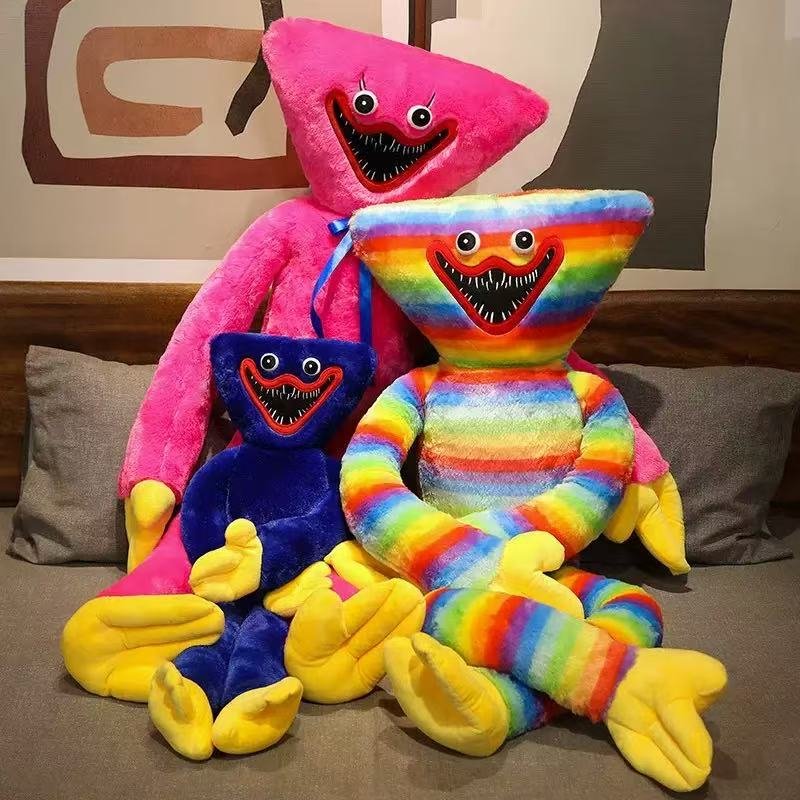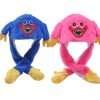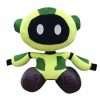
Snuggly teddy bears, colorful bunnies, or sweet tigers – stuffed animals are not just simple toys. Instead, they hold an emotional value that occupies a different place in every child’s life.
Babies often come into contact with stuffed animals for sleep in the first few months. When they catch sight of a little cuddly friend, they quickly become enchanted, and the cuddly companion accompanies them through every further developmental phase.
But how do you introduce your babies to stuffed animals for sleep, and what should you pay attention to when leaving them with your little ones for sleep and play? These questions have probably accompanied you during pregnancy.
There is usually no right or wrong. Your parental intuition will guide you in the search for answers because only you know your little dreamers best. Five Star Toy has compiled all the essential information and tips about stuffed animals and other sleep aids for sweet dreams.
When babies come into the world, they feel a great need for physical closeness, security, and a huge amount of affection and love. The sleep rhythm is initially quite erratic.
Gradually, you and your baby will get used to each other, and your sleep habits will adjust. However, occasional sleep problems for your little ones may still occur, costing you sleep as well.
Sleep problems usually occur, especially when your babies are hungry, have colic or (growth) pains, teething, find light or noise disturbing, or perceive room temperature as uncomfortable.
The physical closeness of you, the parents, usually works wonders, and the little ones can be comforted.
To make sleep even more comfortable – for you parents as well – sleep aids such as stuffed animals and pacifiers are the perfect way to get through the night more relaxed. Stuffed animals can provide your infants and toddlers with a lot of comfort and security.
Paired with your parental scents and a cuddly soft silhouette, your babies don’t feel so alone. Thus, they experience less fear, and they sleep better.
Stuffed animals usually consist of two main elements: the fabric covering made of synthetic or natural fibers and the filling made of cotton, synthetic fibers, or granules. However, the very first cuddly friend allowed to make itself comfortable next to your infants in bed should not be made of plush.
Plush tickles too much when chewed on and also carries the risk of swallowing fibers. Instead, for the first stuffed animal, you should opt for terry cloth. Generally, in the initial period, only a single stuffed animal in bed is recommended so that your babies can breathe freely and have more freedom of movement.
Popular stuffed animals include various types of animals as well as comic characters or fantasy creatures. A teddy bear is probably one of the world’s most famous stuffed animals. In every generation, there is hardly a person who has not owned a cute cuddly bear.
What to consider when buying?
Quality and safety: Stuffed animals should be free of harmful substances and easy to care for. The outer fabric and filling are usually crucial for whether the cuddly friends can be cleaned in the washing machine or not.
Filling: The filling should be soft and fluffy. Plush, terry cloth, and microfiber are the best choices. However, in the first months of your infants’ lives, rougher terry cloth stuffed animals are the better option, as the focus should not only be on a soft feel.
Processing: Stuffed animals should be securely sewn and able to withstand any resistance. Your children will take them on many different journeys from infancy to elementary school, so they should be as robust as possible.
Washability: It’s best if you can easily wash the stuffed animals so that you can clean them regularly and quickly.
Quality seals and standards: Your stuffed animals should all have a CE marking, indicating that they comply with applicable European guidelines. Also, an LGA quality seal (indicating toxin-free processing) is essential, as well as a TÜV seal, showing that the stuffed animals have been tested on various educational and technical levels.
Size: The stuffed animal should match the height of your child; otherwise, cuddling will be uncomfortable.
The significance of stuffed animals for your babies
If you introduce your babies to stuffed animals in the first few months of their lives, it is very likely that they will want to have their new favorites with them in further developmental phases and see them as their best friends. Their fabric or plush toy becomes their protector in many ways. Stuffed animals interrupt the feeling of being alone, giving your children comfort and security that only Mom and Dad can fulfill.
Moreover, they are their strengthening friends when they get scared in the dark. If they wake up at night and Mom and Dad seem too far away, their cuddly friends give them the feeling that nothing will happen to them. This is often due to the scents associated with your babies. So, when cuddling, hugging, and playing with the stuffed animals, there is always a scent of parental love in the air. Stuffed animals have immeasurable emotional value.
They accompany your babies not only to sleep but also start the day together. The soft friends provide comfort and strength in various situations. For example, when it’s time for a nap, and your little ones don’t want to rest, their favorite stuffed animals help them handle their emotions. If you explain to your children that even a stuffed animal needs a nap, going to bed becomes easier – after all, they are not alone. Teaching them to shift emotions in a playful way helps them understand different connections.
For toddlers, school-age children, and often beyond, stuffed animals are worry-eaters and true everyday companions, processing experiences together with them. Playing with them also teaches your kids social skills. Role-playing and imitating everyday situations train them in dealing with others. So, the first visit to kindergarten or elementary school becomes much easier for the little ones.
The motor development is also promoted by handling plush animals. The different elements and a mix of firm, soft, or rough components stimulate and train all the senses when touched. In general, stuffed animals are beneficial for your children – and they will surely bring a smile to your face from time to time.
Sweet Stuffed Animals
Adorable pacifier bunnies, cuddle pillows disguised as friendly elephants, or a soft puppy – stuffed animals come in the form of numerous animal species and characters. They are your children’s most loyal companions and of outstanding emotional value. Click through the Five Star Toy range and find the perfect stuffed animals for your kids.
How to Introduce Your Babies to Stuffed Animals for Sleep
Your babies need time to gradually get used to a regular day and night rhythm in the first few months of their lives. They learn it completely anew, so patience is required.
It won’t always be successful in getting your little ones to sleep calmly and relaxed. If you want to use sleep aids like pacifiers and stuffed animals, you can easily practice handling them: farewell to worries.
To ensure your babies sleep well, create a certain atmosphere of well-being. Make sure the cot is not too crowded, and initially, use only a terry cloth stuffed animal for acclimatization. The ideal bedroom temperature is just as important as suitable sleepwear. In general, you should approach the topic of falling asleep in a relaxed manner. Your babies will not be able to fall asleep equally well every day, and the use of stuffed animals for sleep will not work every single day.
Practice makes perfect. Create bedtime rituals that make your children feel that they can now close their eyes calmly and enter their dream world.
Also, let the cuddly companion come into play during the day – during playtime, cuddling, or even naptime. Only then will it be accepted in bed as a real cuddly friend and comforter.
How Many Stuffed Animals Do Children Need?
Usually, your children decide on a stuffed animal in the first few months that they want to accompany them on their further life journey. They see it as their best friend, whom they wouldn’t give up for anything or anyone.
However, if their best friend shows first signs of wear and tear after years, it is difficult for your kids to understand. To prevent such heartache, you should have at least one or two additional cuddly friends in reserve during the acclimatization phase. Change them regularly so that your kids also get used to these cuddly friends just in case.
If the favorite stuffed animal is ever lost or is only temporarily gone for a wash, the outcry is less significant. Although your kids will notice that it is no longer their favorite stuffed animal, they will cope with the loss more easily if another familiar cuddly friend is by their side.
Stuffed Animals: Best Friends Until Elementary School
Stuffed animals accompany your children for a long time in their lives. From infancy to elementary school or even occasionally beyond, your children see plush and fabric animals as friends they can tell everything.
From a psychological perspective, it is the first social relationship that children enter on their own terms – even if you initially only introduced the stuffed animal to them as a sleep aid.
Children discuss their worries, fears, and plans with their stuffed animals. Even if they don’t receive a direct response, the stuffed animals still provide comfort and strength, as they get to know their own efficacy. Your kids learn to deal with their emotions and communicate them purposefully. So, an exchange with you about unpleasant topics often becomes easier for them when the plush elephant or teddy bear is present.
Your children learn to expand their social behavior with the help of stuffed animals. Their companions are with them everywhere. Class trips, excursions, as well as kindergarten and school visits, your kids experience with their stuffed friends. This bonds them together.
How to Care for Stuffed Animals?
To ensure that your kids can enjoy their stuffed animals for as long as possible, taking care of them is crucial. This is because proper care is necessary to eliminate household dust mites, dirt like food residues, or other signs of wear and tear, as well as viruses and bacteria. Discover a wide selection of adorable and easy-to-care-for stuffed animals on Five Star Toy. Regular cleaning is especially essential for toddlers, as they might put their stuffed animals in their mouths. When it comes to caring for them, pay attention to the labels on your plush toys. If they are suitable for the washing machine, follow these steps:
- Place the stuffed animals in a bag and seal it airtight. If you’re concerned about mites and the like, you can put the bag in the freezer for 48 hours before washing to kill them off. After two days, vacuum the surface thoroughly to remove the mites and their excretions.
- To protect eyes and other sewn-on parts, it’s best to put the stuffed animals in a laundry net. Then, clean them in the washing machine at 30 degrees Celsius. If you want to kill viruses and bacteria, it is recommended to use a disinfectant detergent.
- Finally, let the freshly washed stuffed animals air dry. Do not put them in a dryer, as they can deform or lose color. Also, avoid direct sunlight. For drying, place the plush toys on a terrycloth towel and turn them at regular intervals.
If your stuffed animals are not suitable for the washing machine, you can dab stains with a damp cloth or hand wash them in a mild soapy solution and then rinse them.
Frequently Asked Questions about Stuffed Animals as Bedtime Aids for Babies
1. Up to what age should babies be allowed to play with stuffed animals?
Sleeping, cuddling, and playing – stuffed animals are important companions during certain phases in your children’s lives. There is no set rule on how long babies should play with stuffed animals. They decide on their own. Generally, these cuddly friends accompany them into elementary school age. They see their favorite stuffed animals as best friends, comforters, and loyal companions who help them process both sorrow and joy. If your children want to keep their plush toys for an extended period, you should not hinder them. The time to set aside their cuddly friends will naturally come on its own.
2. At what age can babies sleep alone?
The age at which babies can fall asleep and even sleep through the night without parental closeness cannot be answered universally. Every child is unique. Some babies sleep alone in the first months, while others may need a lot of companionship into toddlerhood. Regardless of how long your children need your closeness to fall asleep, give them the time. Periodically, your little ones may be able to fall asleep alone and then, at other times, less independently. Sleep aids such as stuffed animals, comfort blankets, or soothing melodies are an optimal choice to gradually acclimate your babies to sleeping alone.
3. What can we do if we have received too many stuffed animals for our babies?
A stuffed animal for Christmas, another for Easter, and yet another for a birthday. Over several years, you may accumulate quite a collection of stuffed animals – especially if relatives surprise you with these sweet presents. Since your babies usually only need one favorite stuffed animal and perhaps one or two more soft toys, the rest may seem a bit lost. However, managing the excess is quite simple. Discarding is never an option, but you can surely reach an agreement with your children: for each newcomer that should stay, select one of the older creatures to “migrate” and move into a new home. Specifically, this means donating, giving away, or selling the older stuffed animals to social institutions. Your children will part more easily with their favorites knowing they are making other children happy.











Leave A Comment